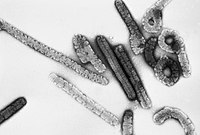
Photo from wikipedia
The present study aimed to understand the pollen morphological variation among and within the Rosa L. species of Western Himalaya, India, and to investigate whether the pollen characters may help… Click to show full abstract
The present study aimed to understand the pollen morphological variation among and within the Rosa L. species of Western Himalaya, India, and to investigate whether the pollen characters may help to distinguish these species of roses. The pollen morphology of nine Rosa species viz. R. canina L., R. centifolia L., R. damascena Mill., R. foetida var. persiana (Lem.) Rehder, R. moschata Herrm, R. multiflora Thunb, R. nanothamnus Boulenger, R. webbiana Wall. ex Royle, and R. macrophylla Lindl were studied. A total of 31 accessions of roses were collected from Jammu and Kashmir, Ladakh, and Himachal Pradesh. Ten quantitative characters, i.e., length of the polar axis (P), length of equatorial axis (E), exine thickness (Ex), length of colpi (LeC), width of striae (Sr), width of groove (Gr), number of striae (Ns), Polar area index (PAI) and P/E ratio were studied. The measurements and observations were carried out with both light microscopy and scanning electron microscopy. Pollen grains of all the studied species were tricolporate. Prolate and subprolate shapes were the dominant pollen shape types. The highest and lowest polar axis length was observed for R. canina (32.73 µm) and R. moschata (25.42 µm), respectively. The average colpi length in the studied species was 22.19 µm, with R. macrophylla having a minimum length of 13.42 µm and R. canina with a maximum length of 34.03 µm. Results of the principal component analysis indicated that the principal component (PC1) attributed 42.10% of the total variation, and positively associated with P, E, LeC, and Ns. Exine ornamentation almost distinguished all the species of Rosa in this study.
Journal Title: Genetic Resources and Crop Evolution
Year Published: 2020
Link to full text (if available)
Share on Social Media: Sign Up to like & get
recommendations!